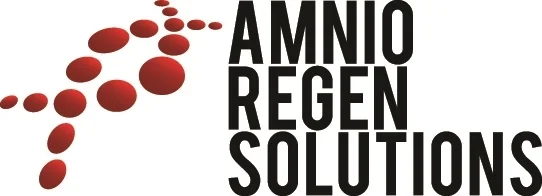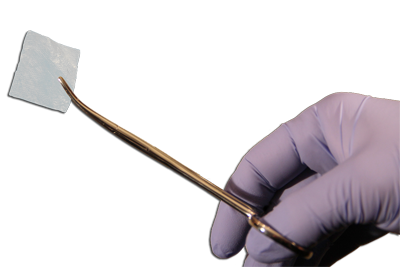About PalinGen® Xplus Membrane
Resorbable, Chorion Free, Dry Amniotic Cross-linked Membrane
An advancement in regenerative medicine utilizing minimally manipulated amniotic tissues, PalinGen® XPlus Membrane is a human allograft comprised of amniotic membrane, providing a wound covering and support for native tissues. Just as the amniotic membrane provides biologic and physiologic properties and acts as a physical barrier to cover and protect the fetus during pregnancy, Amnio Technology allografts provide a biological and physical overlay to support and protect the wound in vivo.
PalinGen® XPlus Membrane contains key growth factors, cytokines, amino acids, carbohydrates, hyaluronic acid, extracellular matrix (ECM) proteins, and cellular components recognized as intrinsic to the complex wound healing process1. Published studies on the benefits and efficacy of amniotic tissue in wounds date back over 100 years2. Amniotic tissue is a rich source of various biologically active factors involved in tissue regeneration and wound healing with reported anti-inflammatory, anti-bacterial, reepithelialization, and anti-fibrotic properties3,4. Class II antigen expression is also mitigated in amniotic tissues, minimizing immunogenicity and reducing risk of graft-host reaction5. As a result, amnion-derived allografts make an attractive wound biomaterial.
Key growth factors found in PalinGen® allografts include:
· Fibroblast Growth Factor (FGF)
· Epidermal Growth Factor (EGF)
· Platelet Derived Growth Factor (PDGF) A & B
· Vascular Endothelial Growth Factor (VEGF)
· Transforming Growth Factor beta (TGFβ)
Extracellular matrix elements found in PalinGen® allografts include:
· Collagen Types I, III, IV, V and VII
· Laminin
· Fibronectin
· Tissue Inhibitors of Metalloproteinases(TIMPs)
· Proteoglycans
· Hyaluronic Acid
PalinGen® XPlus Membrane provides greater tensile strength, shape manipulation and slower resorption versus PalinGen® Membrane and Hydromembrane. These products are available in a variety of sizes.
PalinGen® products do not require fetal sacrifice and recovery is performed with maternal consent during elective Cesarean delivery.
PalinGen® XPlus Membrane donor tissue is recovered using one of the safest recovery techniques and sterile equipment to minimize bioburden contamination. Amniotic tissues are procured through a network of qualified and trained recovery partners, following stringent screening and recovery protocols in a highly controlled processing environment. All tissues are processed aseptically and sterilized.
Donors are prescreened through an intensive and complete medical review and prenatal evaluation. Communicable disease testing is performed by an FDA registered and Clinical Laboratory
Improvement Amendments (CLIA) laboratory. Donor blood sample is taken prior to or at the time of recovery and tested for HBsAg, HBcAb, HCVAb, HIV1/2 Ab, HCV NAT, HIV NAT, HBV NAT, RPR/STS, HTLVI/II and WNV. Allografts are subjected to stringent USP testing prior to release.
PalinGen® products are manufactured and regulated for human homologous allograft use under 21 CFR Part 1271 and Section 361 of the Public Health Service Act.
PalinGen® tissues are processed and packaged a t an FDA registered and American Association of Tissue Banks (AATB) accredited facility in accordance with cGMP standards.
About Amnio Technology:
Amnio Technology, LLC is a global leader in the development and use of amnion-derived technologies. Amnio Technology enhances the gift of human birth tissue donation by developing, pr ocessing and distributing innovative allografts that provide regenerative therapies to improve quality of life. Learn more at www.amniotechnology.com.
PRODUCT NOTES
· Allografts may be sutured, glued, or simply positioned based on clinician preference
· May be trimmed to any desired size and shape
· Easily resorbed in vivo
· Chorion free
· Available in a variety of sizes
· Recommended storage is in a clean, dry environmentat ambient temperature until expiration
· Membranes may be refrigerated
· See package insert for complete Instructions For Use
REFERENCES:
1) Complements and the Wound Healing Cascade: An Updated Review. Hani Sinno and Satya Prakash. Plast Surg Int. 2013; 2013: 146764
2) The Grafting of Preserved Amniotic Membrane toBurned and Ulcerated Surfaces, Substituting Skin Grafts: A Preliminary Report. Maximilian Stern. JAMA. 1913; 60(13): 973-974
3) Amniotic Fluid: Not Just Fetal Urine Anymore. Mark A Underwood, William M Gilbert, Michael P Sherman. Journal of Perinatology. 2005; 25:
4) Growth factors and cytokines in wound healing. Barrientos S, Stojadinovic O, Golinko MS, Brem H, Tomic-Canic M. Wound Repair Regen. 2008; 16(5): 585-601
5) Immunological characteristics of amnioticepithelium. Hori J, Wang M, Kamiya K, Takahashi H, Sakuragawa N. Cornea. 2006; 25(10): S53-58
Uses Documented in Literature
- Orthopedic Surgery – Augment tendon, fasciae, ligament and capsule repair.
- Neuro Surgery – Dura supplementation and repair, nerve wrapping to reduce risk of entrapment or adhesion, and repair injured nerve bundles.
- Spinal Surgery – Reduce scarring, and fibrosis. Reduce risk of nerve entrapment when used as anti-adhesion barrier.
- General Surgery – Hernia repair, protect nerve, reduce scar formation and adhesions, augment tissue repair.
- Urologic Surgery – Supplement surgical repair, use in prostatectomy as a nerve wrap to reduce risk of adhesions/ entrapment.
- Burn Specialists – Excellent topical wound therapy as anti-microbial, anti-inflammatory and reduce scarring.
- Wound Specialists – Excellent topical wound therapy provides a healthy anti-microbial, regenerative wound environment.
- Dental Surgery – Post procedure topical wound covering, potential to resolve gum insufficiency.
- Plastic Surgery – Uses include as an anti-fibrotic tissue barrier to prevent adhesions, or to supplement damaged tissue are a few types of uses in this wide ranging specialty.
PalinGen Membranes are readily available in sizes up to 4x6cm (larger sizes available upon request)

